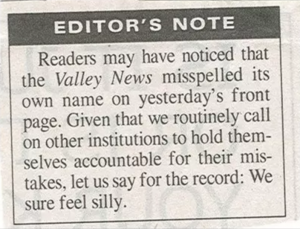An update on our journalistic corrections initiative

 What happens when you get people from major news organizations, tech platform companies and academia into a room to talk about journalistic corrections and how to make them more effective in a digital media environment? We’re going to find out next week when about 20 of us gather at Civic Hall in New York City, as we move our News Co/Lab project on corrections into its next phase.
What happens when you get people from major news organizations, tech platform companies and academia into a room to talk about journalistic corrections and how to make them more effective in a digital media environment? We’re going to find out next week when about 20 of us gather at Civic Hall in New York City, as we move our News Co/Lab project on corrections into its next phase.
When we announced this initiative several months ago, we called corrections and major updates “an essential kind of transparency” for journalists of all kinds — and “also by far the most common form of post-publication fact-checking.” We said we’d be working to upgrade the process for digital media in ways that would help promote trust in journalism, and, we hope, much deeper connections among journalism organizations and the communities they serve. We’d do that with experiments, research and an in-development software tool to make it easier for journalists to propagate corrections and key updates in ways that mirror the original posts and shares.
In the several months since we announced the initiative, we’ve made significant progress. Most notably, Ted Han has signed on to be our software developer, though he brings much more than programming skills to the project, as noted in my previous blog post.
Ted joined me and Kristy Roschke, the News Co/Lab’s managing director, at the Online News Association’s annual conference a few weeks ago to describe the project and get feedback from people who cared about the topic. We were jazzed (the ONA meeting was in New Orleans; cough) to find out that quite a few people care about this. We got useful feedback, including a number of pertinent questions and some good advice.
As we’ve been preparing for next week’s New York session and thinking through the new software project, the News Co/Lab has been pulling together a scan of what research we can find on journalistic corrections. We’ll be publishing that separately, but the bottom line for me is that we need a lot more research in this field. One of the specific purposes of building the new tool, which journalists will use to make corrections travel down the same social-media pathways as the original mistakes, is to fuel deeper research. (We’re particularly pleased that Brendan Nyhan, a Dartmouth College political scientist who’s done some of the finest research in the larger sphere if misinformation, is working with us on the project as well.)
We’re also collecting corrections policies that news organizations have posted publicly (and some that are not public). They vary, of course, but a common thread is a desire to be transparent and honorable. I’d love to see more journalism organizations post policies, and even more to think about coming up with an industry standard — publishing formats, essentially — that would let outside researchers analyze what kinds of corrections work best in reducing people’s misunderstandings of vital issues.
At one session in next week’s meeting, we’ll ask the newsroom representatives: “If you could magically make it happen tomorrow, what would you do to improve your audience’s experience in learning that you updated/corrected something important?” I can’t wait to hear the answers.
As always, we’re grateful for support for this project from Craig Newmark Philanthropies. And we’re big fans of Civic Hall and its work.
Dan Gillmor is a longtime participant in new media and digital media literacy. He’s author of the 2009 book, Mediactive, discussing media literacy in the digital age from a journalist’s perspective.
